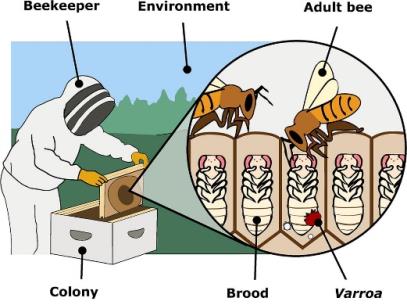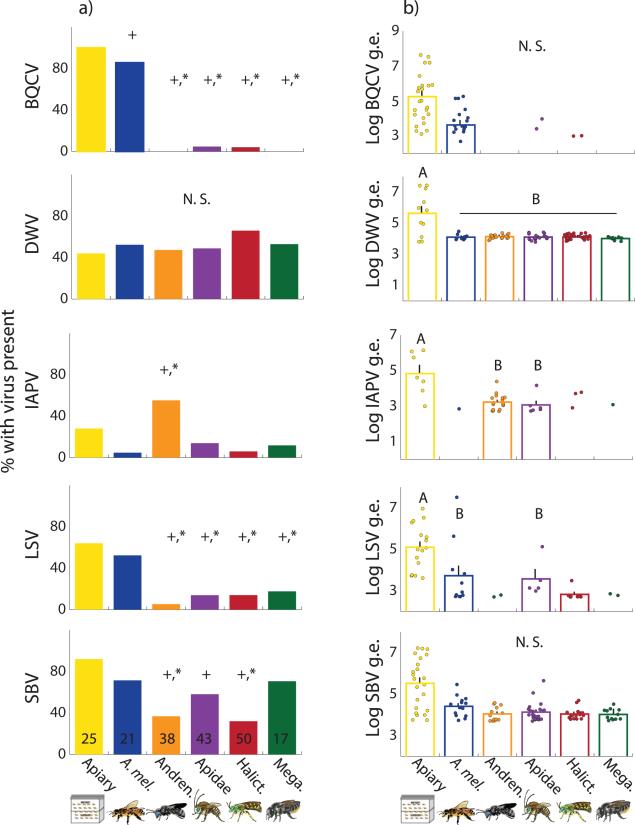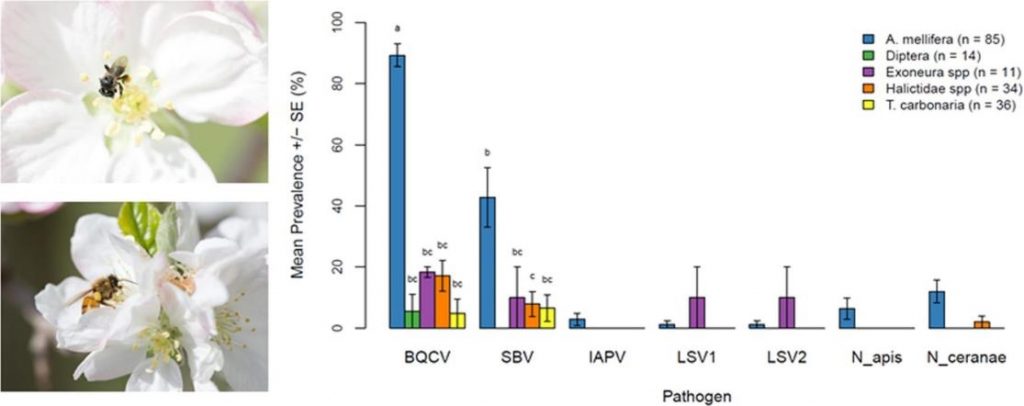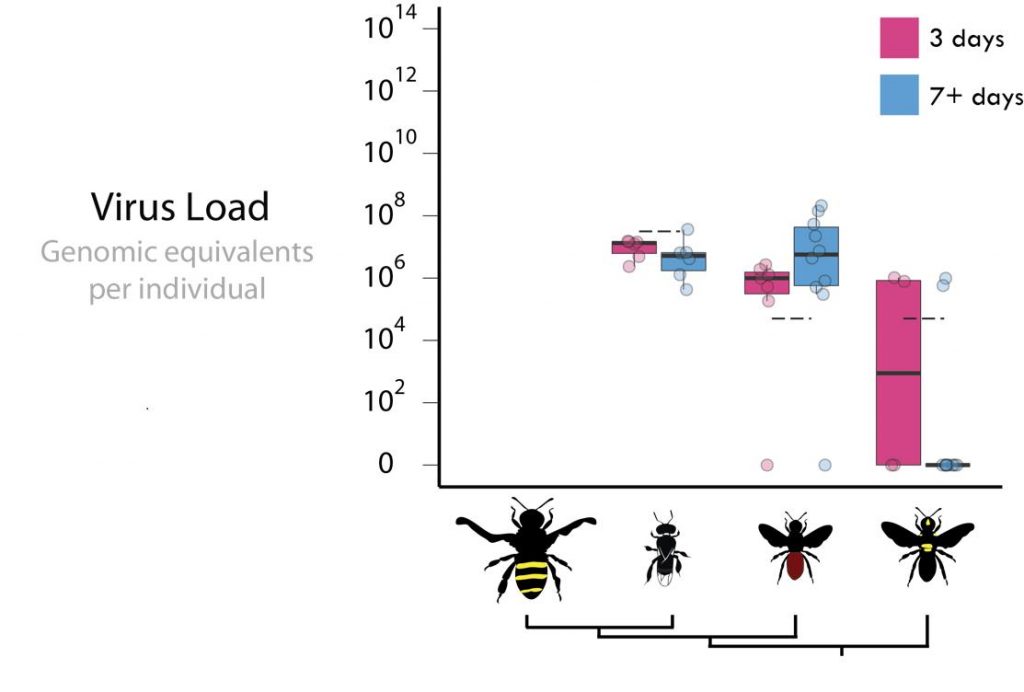By Tim Heard, James Cook, Amy-Marie Gilpin, Ros Gloag, Dean Haley, Mark Hall, Katja Hogendoorn, Shahid Mehmood, Ben Oldroyd and Tobias Smith Endorsed by the Australian Native Bee Association Management Committee
Fast Facts
• Varroa mites are specific to honey bees and will not feed upon native bees.
• The establishment of Varroa mites may have indirect, knock-on effects on native bees.
• Indirect effects include disease transmission, reduced competition from honey bees and chemical poisoning.
• Indirect effects could have a positive or negative impact on the health and abundance of native bees.
• Increased disease transmission and chemical poisoning may have negative impacts.
• Freedom from competition with honey bees may have a positive effect.
• The final impact of varroa mites on native bees is difficult to predict but an understanding of the possible interactions will inform us of what to look for.
Introduction
Varroa mites were detected on 22 June 2022 at the Port of Newcastle NSW in sentinel hives of European honey bees (Apis mellifera) and in nearby commercial hives. The Varroa destructor mite is one of the most significant pests of honey bees worldwide; but until now, Australia remained free. It is an external parasite that feeds on fat body (a critical tissue) of adult and immature honey bees. It weakens the bees and spreads lethal viruses. Many viruses associated with bees are found in greater numbers when Varroa is present. The combined effect of the mite and the viruses often leads to colony death within a year or two unless the pest is managed by a bee keeper. Figure 1 shows the Varroa mite in context.

An eradication program in NSW is currently underway. Native bee keepers grasp how distressing it must be for apiarists to witness the destruction of their hives. Government and industry are hopeful that their efforts will be successful, but the record of eradicating Varroa in other countries is dismal. If eradication is not achieved, Varroa will probably spread within a few years to most of Australia; perhaps Tasmania and WA can keep it out. If the eradication program is successful, it will still take years to confirm success; meanwhile disruption to honey bee industry operations and pesticide treatments to ensure eradication of Varroa will continue. Even if this incursion is eradicated, future incursions are likely to occur. Hence, we need to continue to prepare for an Australia with Varroa. The impact on the honey bee industry and the farmers who depend on bees for crop pollination will be substantial. Many other countries have learnt to live with Varroa and continue to have strong honey bee industries (IPBES 2016). Their experiences will be invaluable in helping Australia to adapt. But what about the effect of Varroa on Australian native bees and the natural environment? We do not know enough to predict the outcome of this ecological invasion. But Varroa invasions have occurred around the world before, and these inform us what could happen here. We list some of the potential outcomes, with a focus on the impact on native bees and pollination services to agriculture and the environment. While we have little ability to predict the extent of these impacts, we can perhaps manage them better if we know what to look for.
Direct impacts are highly unlikely
There are a several ways by which Varroa could affect native bees and the environment – either directly or
through various indirect means. We do not expect any direct impact of Varroa mite on native bees. The direct threat is only to honey bees in the genus Apis because the mite breeds only in honey bee hives and will not attack or feed on other bee species. The biology of this parasitic mite is closely tuned to its honey bee host. This makes it extremely unlikely to switch its host range to Australian native bees with their very different evolutionary histories and nesting behaviour. We are confident of this because the Varroa mite
occurs alongside many species of non-Apis native bees in its native home in Asia, and has done so for thousands of years, with no reported cases of the mite breeding in non-Apis bee’s nests. Same for other parts of the world where the mite has been introduced. NSW DPI recognize that Varroa mite does not present a risk to native bees nor are native bees a carrier of the mite. They have excluded native bees and native bee hives from the emergency response. Native bees and native bee hives can therefore be moved legally in NSW.
Indirect impacts
Native bees may be indirectly impacted by Varroa mites, including through viral diseases, decline of feral honey bees, and pesticide poisoning. These impacts on native bees may be positive or negative.
Disease transmission
Honey bees are susceptible to viruses. The cosy hive provides warmth, humidity, and frequent body cont act between adults and vulnerable larvae. Plus, all members of the colony are genetic similar so if one individual gets infected, then everyone is susceptible. Bees have defences within their body and social bees also benefit from social immunity, for example, foragers collect plant resins and bring them back to the colony protect against pathogens. Nevertheless, a diverse suite of about 20 virus species thrive in honey bee colonies. New molecular biology tools allow the use of DNA to identify viruses infecting bees, even if there are no symptoms. The data for managed honey bees show that the currently documented viruses are distributed globally. Migratory beekeeping tends to increase the prevalence of viruses in honey bee colonies (Martínez-López et al 2022). Notably though, Deformed wing virus, the most prevalent and destructive virus of honey bees, has not been found in Australia. Varroa mites cause the deformed wing virus to proliferate in honey bee colonies. This virus increased its frequency among honey bee colonies from 10% to 100% when the mite was introduced into Hawaii. This change was accompanied by a million-fold increase in the number of virus particles infecting each honey bee (Martin et al., 2012).
Do viruses of honey bees spill over to wild bees?
Many of these viruses are multi-host. For example, Alvarez et al. (2018) confirmed three viruses: (ABPV acute bee paralysis virus, DWV deformed wing virus, IAPV Israeli acute paralysis virus) in four species of stingless bees and feral honey bees in Argentina. There is increasing evidence of virus transmission from managed honey bees to wild bees, a process called spill over. Contaminated bees can shed the virus particles when visiting flowers or other resources. The viruses are transmitted to other bees when they visit these flowers and consume the pollen and nectar. Viruses may also spread between bee species when they nest close by. Piot et al., (2022), found a strong link between the viral prevalence in wild bees and coexisting honey bees. This result confirms earlier studies that demonstrate that viral prevalence in wild bees is related to viral prevalence of sympatric honey bees.
Do these viruses cause serious disease in native bees?
Dolezal et al. (2016) found that honey bee viruses common at low levels in many wild bee species, but do not cause them any harm. Dolezal et al. (2016) tested 169 bees, representing four families, for five common honey bee viruses and found that more than 80% of wild bees harboured at least one virus. They also quantified virus load in these wild bees and found virus levels to be minimal (Figure 2). Furthermore, they inoculated adults of two bee species (Megachile rotundata and Colletes inaequalis) with a mixture of common viruses that is lethal to honey bees and saw no effect on short term survival.

Figure 2. Occurrence and abundance of five viruses in honey bees and wild bees (from Dolezal et al., 2016)
a) Percentage of each bee group detected with the five viruses tested: BQCV, DWV, IAPV, LSV, SBV. * and + denote significantly different from field-collected or apiary collected honey bee samples.
b) An estimate viral genome copy number in 200 ng of total RNA) of BQCV, DWV, IAPV, LSV, and SBV in bees with detectable levels of each virus. Letters denote significant differences.

Figure 3. Graphical abstract from Brettell et al, 2020 showing the percentage of individuals testing positive to seven bee pathogens on honey bees and four Australian native bee species. BQCV = Black Queen Cell Virus, SBV=Sacbrood Virus, IAPV=Israeli Acute Paralysis Virus, LSV1 = Lake Sinai Virus 1, LSV-2= Lake Sinai Virus 2, and fungal pathogens, N_apis=Nosema apis, N_ceranae=Nosema ceranae.
What do we know about virus spill-over to Australian native bees?
Evidence for spill-over has been found in the Australian environment (Figure 3). Native bees contain more viruses where honey bees’ virus loads are high. This occurs even in the absence of Varroa. With Varroa, honeybees will carry higher virus loads and so we predict some native bees will be similarly afflicted. A second line of evidence is from lab studies investigating whether, if you inject some honey bee viruses into native bees, the viruses can replicate and cause disease. The results of one of these experiments shows that deformed wing virus can replicate in reed bees, but not in others (Figure 4).
However, importantly, while those viruses are transmitted to native bees, and can replicate in some species after inoculation, it is as yet unclear whether they cause disease. In experiments at the University of Adelaide by honours student Nicholas Congedi, significant mortality of pupae of Tetragonula carbonaria was only observed after inoculation with very high concentration of Sac Brood Virus. It is important to understand that the faecal -oral transmission is extremely unlikely to lead to such high concentrations.
Decline of feral honey bees
In every other beekeeping country where Varroa has invaded, managed honey bee colonies initially suffer losses and then recover as beekeepers learn to manage this pest. Feral colonies, on the other hand, do not recover, their colony numbers remain low. Feral honey bee colonies are common in many Australian landscapes. The decline of feral colonies could have several impacts on native bees, farmers and apiarists, including the following three.
Impact on native bees
Native bees and other native animals may benefit through a release from competition for food and nest sites. Populations of native bee species that experience competition from honey bees are expected to respond with greater abundance and diversity. This pertains in particular to larger generalist bees, such as carpenter bees, that cannot find sufficient food in places where competition with honey bees is intense. Impact on agriculture Farmers may experience changes in the yields of pollination dependent crops. The increase in native bee numbers is unlikely to offset the reduction of feral honey bees, depending on the ecosystem, the crop and the season. In broadacre winter-flowering pollination dependent crops, such as almonds, we do not expect that native bees can replace honey bees. In crops grown in a complex land use matrix, the release from competition with feral honey bees may increase native bee populations. A diverse pollinator community provides better pollination than a community dominated by honey bees, because different pollinator species have different food preferences, foraging behaviour and activity patterns. Impact on honey bee keepers Apiarists may benefit by better honey yields and performance of their managed hives through a decline in competition from feral honey bees for food.

Impact of Varroa mite eradication pesticides
The government authorities and honey bee industry are committed to eradication of Varroa mites. They are mapping infestations and establishing management zones around them. The eradication program will evolve rapidly but will include destroying infected hives and attempting to destroy other nearby hives with baits. Bait stations consist of a sugar syrup attractant laced with an insecticide (fipronil). According to the NSW DPI website, the bait stations will contain only sugar solution until they are observed being visited by honey bees. At that time, syrup is replaced with fipronil laced syrup for one hour only. The bait will be monitored for that time to ensure non-target animals such as native bees, will not be exposed to the chemical. This sounds like a reasonably safe strategy, but we are wary about the insects (wasps, ants, bees) and possibly also vertebrates that collect the toxic honey after the feral honey bee colony has died.
Many relevant questions remain unanswered. We don’t currently know the toxicity of the fipronil syrup concentrations being used to native bees such as stingless bees. Is it possible that stingless bees that consume it at bait stations will die before they make it home, thereby reducing the likelihood of negative impacts on the colony? And how much does it take to kill a feral honey bee colony? How toxic does their nest become? It seems that fipronil is residual for a long time, so poisoned feral honey bee nests could be toxic for many months. These questions require urgent investigation. We will be communicating with the authorities to raise awareness and questions regarding the baiting strategy. For example: what action will the observer take if stingless bees turn up to a bait station? Will the observer attempt to kill them before they fly home and recruit nest mates resulting in injury to the entire colony? Will the observer shut down the station if non-target bees are observed visiting? In the meantime, we are making plans for the removal of stingless bee hives from control areas if we deem the pesticide treatments to be a significant threat. Another option to protect managed stingless bee hives is to close their entries with a ventilated closure. This would require good communication from the authorities about when and where the baits are being activated.
Summary
The Varroa mite is likely to establish in Australia sooner or later. To prepare for it, we should consider possible consequences to our native bees and to pollination services generally. Direct effects of the mite are unlikely, because Varroa mites do not attack native bees. However, both positive and negative indirect effects through the impact on honey bees, are foreseeable. On the one hand, in many areas, there will be a release from competition with feral honey bees, which is likely to benefit native bees. On the other hand, bee viruses will initially become more prevalent in honey bees and this will increase spill-over to native bees. However, while research is needed to investigate the consequences of viral spill over to native bees, the overseas evidence suggests the impact of this may be limited, as viruses generally do not cause disease in native bees. We also need to take care that pesticides used in the Varroa eradication program do not affect native bees.
Literature cited
Alvarez, L.J. et al. (2018) Detection of honey bee viruses in Argentinian stingless bees (Hymenoptera: Apidae). Insect. Soc. 65, 191–197. https://doi.org/10.1007/ s00040-017-0587-2 Brettell, L.E. et al. 2020, Occurrence of honey bee associated pathogens in Varroa-free pollinator communities, Journal of Invertebrate Pathology, 171, 107344, https://doi.org/10.1016/j.jip.2020.107344. Dolezal A.G. et al., (2016) Honey Bee Viruses in Wild Bees: Viral Prevalence, Loads, and Experimental Inoculation. PLoS ONE 11(11): e0166190. https://doi.org/10.1371/journal.pone.0166190 IPBES (2016) Summary for policymakers of the assessment report of the Intergovernmental Science-Policy Platform on Biodiversity and Ecosystem Services on pollinators, pollination and food production. S.G. Potts et al. Secretariat of the Intergovernmental Science Policy Platform on Biodiversity and Ecosystem Services, Bonn, Germany. 36 pages. Download Martin, S.J. (2012) Global Honey Bee Viral Landscape Altered by a Parasitic Mite, Science 336, 1304 https://www.science.org/doi/10.1126/science.1220941 Martínez-López V. (2022) “Migratory beekeeping and its influence on the prevalence and dispersal of pathogens to managed and wild bees”, International Journal for Parasitology: Parasites and Wildlife, 18: 184-193, https://doi.org/10.1016/j.ijppaw.2022.05.004 Piot N. et al. (2022) Honey bees and climate explain viral prevalence in wild bee communities on a continental scale. Sci Rep 12, 1904 ht
